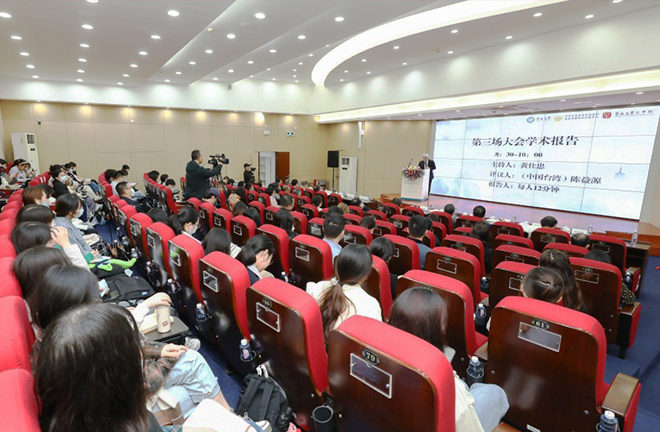Classic Chinese fiction disseminated overseas

A seminar on overseas transmission of classic Chinese novels Photo: JNU
GUANGZHOU—The First International Symposium on Overseas Promotion of Classic Chinese Novels was held in Guangzhou, Guangdong Province, April 8–9.
Overseas contributions
According to Song Xianzhong, president of Jinan University in Guangdong Province, the spread of ancient Chinese fiction overseas not merely represents the reception and re-interpretation from “others,” but also represents a significant engagement with the overseas Chinese community. These works have become an integral part of their cultural and intellectual systems, serving as a carrier of Chinese culture and contributing to the enrichment of local cultural life. Through the deep integration of ancient Chinese novels and their cultural derivatives into the settlements of overseas Chinese, the exchange between Chinese literature and other cultures has been greatly enhanced.
“Overseas Chinese constitute a special cultural group, both receivers and transmitters, in the international dissemination of classic Chinese novels,” said Miao Huaiming, a professor from the School of Liberal Arts at Nanjing University. In the first half of the 20th century, some Chinese emigrated to other countries to evade unrest caused by wars, many of whom were highly educated intellectuals, facilitating the extensive spread of classic Chinese fiction and partly reshaping the culture of overseas Chinese. Translation and introduction efforts not only satisfied their desire to understand and perpetuate their own traditional ethnic culture, but also practically enabled a more widespread dissemination of Chinese culture. These activities and research made by overseas Chinese scholars on ancient Chinese novels are complementary to domestic academia.
According to Pan Jianguo, a professor from the Department of Chinese Language and Literature at Peking University, classic Chinese novels serve as valuable resources for East Asian readers to learn the Chinese language and gain insight into Chinese culture, without creating a sense of cultural heterogeneity. As such, East Asian literati actively devoted themselves to purchasing, collecting, circulating, transcribing, borrowing, compiling, copying, translating, introducing, publishing, and printing ancient Chinese fiction. Classic Chinese novels stored and collected overseas, as well as related research outcomes scored by Eastern and Western sinologists, contribute significant academic resources to Chinese academia.
Voices from sinologists
The research and reinterpretation of ancient Chinese novels by overseas sinologists, as well as the attention paid to overseas sinological research by Chinese scholars, have played a non-negligible role in the preservation and transmission of Chinese culture. This topic has been included in discussion on the inheritance and transmission of Chinese culture.
Song Lihua, a professor from the School of Humanities at Shanghai Normal University, affirmed the research value of American sinologist Patrick Hanan on Chinese language novels, expanding the category of Chinese literature. Hanan integrated the strengths of Chinese and Western research methods, introduced the external research perspectives of “outside text” and “outside literature,” and broke through the classification and research modes of modern novels that have developed towards rigidification, thus widening the research scope of modern fiction.
“Over the past decades, my efforts are mainly focused on the dissemination materials of Ming (1368–1644) and Qing (1644–1911) novels in South Korea, including Jiandeng Xinhua (New Tales for the Trimmed Lampwick) and Dream of the Red Chamber,” said Choe Yongchul, the first chairman of the Chinese Fiction Society in South Korea and a professor with Korea University. Over the past three decades, the growing interest in classic Chinese literature has led to the discovery of new materials and sources both at home and abroad, tremendously driving the overseas dissemination of Chinese novels. The society, founded in December 1989, has focused on collecting literature related to Chinese fiction stored in South Korea, attracting high academic concern in international academia with its pertinent achievements.
According to Kwan-Dong Min, a professor from Kyung Hee University in South Korea, roughly 438 types of classic Chinese fiction have entered South Korea, including 200 in classical Chinese and 238 in vernacular Chinese. The Series of Korean Rare Editions of Chinese Classics is a collaborative collection between the Institute of Chinese Culture and the Center for East Asian Books and Literature at Kyung Hee University and the Center for Overseas Sinology and Chinese Classics Studies at China’s Wuhan University. The collection includes a number of literature editions that were previously scattered or lost in China, and reveals the specific circumstances surrounding certain works that have circulated or been published in Korea. Representing a commemoration of cultural envoys in Chinese and South Korean history, the publication is also conducive to facilitating contemporary bilateral cultural exchanges.
Okazaki Yumi, a professor from Waseda University in Japan, noted that the heyday of Mingaku [Ming-era] music and Shingaku [Qing-era] music in Japan occurred during the Bakumatsu period (the late Edo era) and the early Meiji era. During these periods, Chinese novels and operas were presented and disseminated in the form of singing and playing. In the Edo period, as Japanese tended to receive Chinese fiction and opera in a literature form, Mingaku and Shingaku music were exceptions. Music introduced from China at the time served as a valuable introduction to Chinese folk literature, offering an alternate means for locals to embrace Chinese culture beyond fiction and opera.
The seminar was co-hosted by the Collaborative Center for the Promotion of Chinese Culture in Hong Kong, Macau, Taiwan, and Overseas at Jinan University, the Chinese Society of Folk Literature, and the World Sinology Center at Beijing Language and Culture University.
Edited by YANG LANLAN
